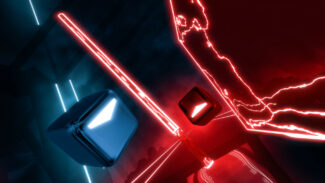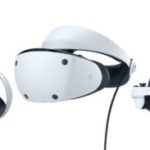With regular updates, DLC releases and changes to the game since launch, Beat Saber remains VR’s poster child. Read on for our updated Beat Saber review for Quest 2, PSVR and PC VR.
Years of Dominance
It’s hard to understate Beat Saber’s influence on the VR industry. It was one of the earliest success stories in VR gaming and became a catalyst for the now-oversaturated market of VR rhythm games. After launch in 2018, it catapulted itself into the spotlight as the must-have VR game for any headset owner and became one of the only VR-exclusive titles to gain brand recognition in the wider gaming industry. As starting points go, it was a good place to be in.
Perhaps more amazing is that in 2022, four years post-release, Beat Saber remains dominant as ever and has never properly faded from the zeitgeist. Meta acquired the studio behind the game, Beat Games, in 2018, but Beat Saber remains available on almost every major VR headset – Meta-owned or otherwise. It consistently holds a near-unbeatable position around the top of most VR store charts, as it has done for several consecutive years now. With consistent free updates and paid DLC releases, there’s now a wealth of content to work through as well.
Even the skeptics would have to admit that Beat Saber is still the biggest VR game in terms of availability, omnipresence and recognition, especially with more casual audiences. But a lot has changed since 2018 – not just advancements in hardware, but also our understanding of solid VR design principles.
The standard is higher than ever, so how well does Beat Saber hold up?
Surprisingly well, is the answer. But before getting into the nitty gritty, let’s cover the basics.
Easy to Understand, Hard to Master
Beat Saber is a VR rhythm game with an easily-understood core concept. Set to music, the player will use two ‘lightsabers’ – one red and one blue, by default – to slice through blocks as they fly through space towards the player. The colour of the blocks – red or blue – correspond to which lightsaber to use, while directional arrows on each indicate whether you should slice up, down, left, right or even diagonally. If you’re confused, think Fruit Ninja… but with music. In VR.
The blocks are aligned to the rhythm of the music – the more on-time and accurately you slice, the higher your score. Slicing consecutive blocks without mistakes builds combos. Missing blocks or making mistakes resets your combo and can stack up to result in a level failure.
There’s other twists as well – walls you have to avoid, bombs you can’t hit, double blocks or cross-armed slices – but overall it’s a conceptually simple game with a very high skill ceiling. Even though the upper echelon of players compete at an insanely high level, everyone can play Beat Saber – the large variety of music, modes and difficulty levels means it’s enjoyable for newcomers and experts alike.
Old Genre, New Platform, Same Feeling
Rhythm games are a popular gaming genre, no matter the platform. But not only does Beat Saber execute the rhythm game tropes well, it also exhibits an expert understanding of what makes a fantastic VR experience – especially impressive for 2018.
Beat Saber’s gameplay isn’t just addictive, it’s tactile. Every move you make lines up perfectly with your expectation for how that action should feel. In other games, actions don’t always align with the virtual world, like putting your hand up against a virtual wall only to realize that your physical hand falls through it.
There’s no such disconnect in Beat Saber. There’s cohesion and responsiveness between your actions in real life and VR, because slicing blocks is designed as an inherently weightless action. Your brain never expects feedback from your actions, so everything just feels right.
This unsolved hardware problem – generating realistic feedback and resistance against actions – is likely to stick around for quite a while. By avoiding the problem entirely, Beat Saber has positioned itself as a timeless experience, at least for the foreseeable future. Even across generations of different hardware, Beat Saber feels incredibly satisfying to play – just as much now as it did in 2018.
Games Modes, Accessibility, Modifiers
Compared to launch, there’s now a lot more on offer in Beat Saber as well. The music library has been massively expanded (more on that later), but there’s also several different game modes to keep you entertained.
The classic mode is Solo, the stock-standard high score mode that lets you play through any track you like, with many optional modifier options. There’s also now a multiplayer mode, which lets up to five players compete against each other for a high score, either in public or private lobbies.
A campaign mode does technically exist, but feels neglected and overdue for a complete overhaul – it’s not worth your time over Solo mode. An upgraded campaign with better structure and some form of progression might be interesting (and perhaps is on the way), but the fairly neglected state of the existing campaign isn’t exactly a huge loss.
Accessibility options and gameplay modifiers are abound in Beat Saber, which let you tailor the game to your needs and wants. You can enable different options to make the game easier, more accessible, harder or just completely different, adding a lot of depth for people who want to mix up gameplay or cater to specific needs.
There’s also special 360 and 90 degree levels that see you turn on the spot as blocks come from different directions – a fun gimmick, but nothing mind-blowing.
An Expansive Library
Given how big the library has grown since launch, Beat Saber’s music selection should have something for everyone by now, provided you’re willing to pay extra.
Humble beginnings saw only a few original electronic tracks included at launch, composed by Beat Games Co-Founder Jaroslav Beck. New free tracks and additional original music from Beck still arrive in updates from time to time, but it’s the paid DLC releases that offer the most exciting selections, featuring some prominent and legendary artists – Linkin Park, Fall Out Boy, BTS, Green Day, Lady Gaga, Panic! At The Disco, Billie Eilish, Imagine Dragons and Skrillex, to name a few.
Each pack brings with it a unique feel, perfectly crafted to capture the spirit of the featured artist. It makes each pack feel truly hand-crafted and brings much-needed variety across the library. The only downside for new players will be the cost – when you add DLC to the cost of the base game, things could start to get a bit pricey.
However, the expansion of Beat Saber’s music selection has also had an effect on consistency. The skill ceiling of Beat Saber players has increased dramatically in the last few years, as has the style and variety of track mapping. While the developers have evolved the game’s mapping, it’s now clear that the difficult labels – Easy, Normal, Hard, Expert, Expert+ – can mean completely different things from one track to another. What was considered Expert in 2018, for example, feels like a walk in the park compared to an Expert map released in 2022.
Room for Improvement
Outside of the actual gameplay, parts of Beat Saber’s user experience are starting to show their age. The entire menu system – large, flat and floating panels, with a point-and-click cursor attached to each controller – might have been serviceable in 2018, but now feels clunky and unintuitive. There’s been lots of innovation in intuitive user experience in virtual reality, but Beat Saber has not kept pace.

The same can be said for the game’s visuals. While overall the game looks great on most platforms, it also doesn’t feel like the best possible visual presentation, especially on Quest hardware. Other releases have really pushed Quest’s standalone hardware to the limit, delivering stunning visuals. It’s hard to believe Beat Saber couldn’t do a bit more to impress in this day and age.
Admittedly, the newer DLC and OST releases feature environments that are way more visually interesting. But if anything, this only contributes to the aforementioned feeling of consistency – some levels look breathtaking, while others now look incredibly dated and barebones.
All of these minor issues are a result of the piecemeal approach taken by Beat Games, adding and changing elements slowly but consistently, bit by bit. While it’s an approach that has served Beat Saber well until now, it’s also segmenting the game and beginning to make it feel less like one cohesive package.
It would be nice to see this addressed, preferably in one big drastic update. Even a full on sequel – Beat Saber 2 – might be the best option, providing a polished and ground-up rework of the core game, while introducing some new elements and transitioning existing players over with legacy map and DLC support.
Beat Saber Review 2022 – Final Verdict
For any new headset owner, Beat Saber remains an essential purchase. Even if the genre is not traditionally your style, the game holds such an esteemed place in VR history and remains completely relevant to modern audiences, exemplifying sublime gameplay that puts intelligent VR design first.
Yes, parts of the experience are starting to feel ever so slightly outdated, but those are very minor gripes for what is otherwise a seminal VR game. Nothing has yet to penetrate the virtual reality zeitgeist quite like Beat Saber. If you have a headset, you have to try it. It’s as simple as that.

Beat Saber is available on Oculus Quest and Meta Quest 2, PC VR via Steam and Oculus, and PSVR.
UploadVR recently changed its review guidelines, and this is one of our new Essential review labels. You can read more about our review guidelines here.
This review was conducted primarily on the Quest 2 version of the game, but applies to all platforms. What did you make of our Beat Saber review? Let us know in the comments below!










